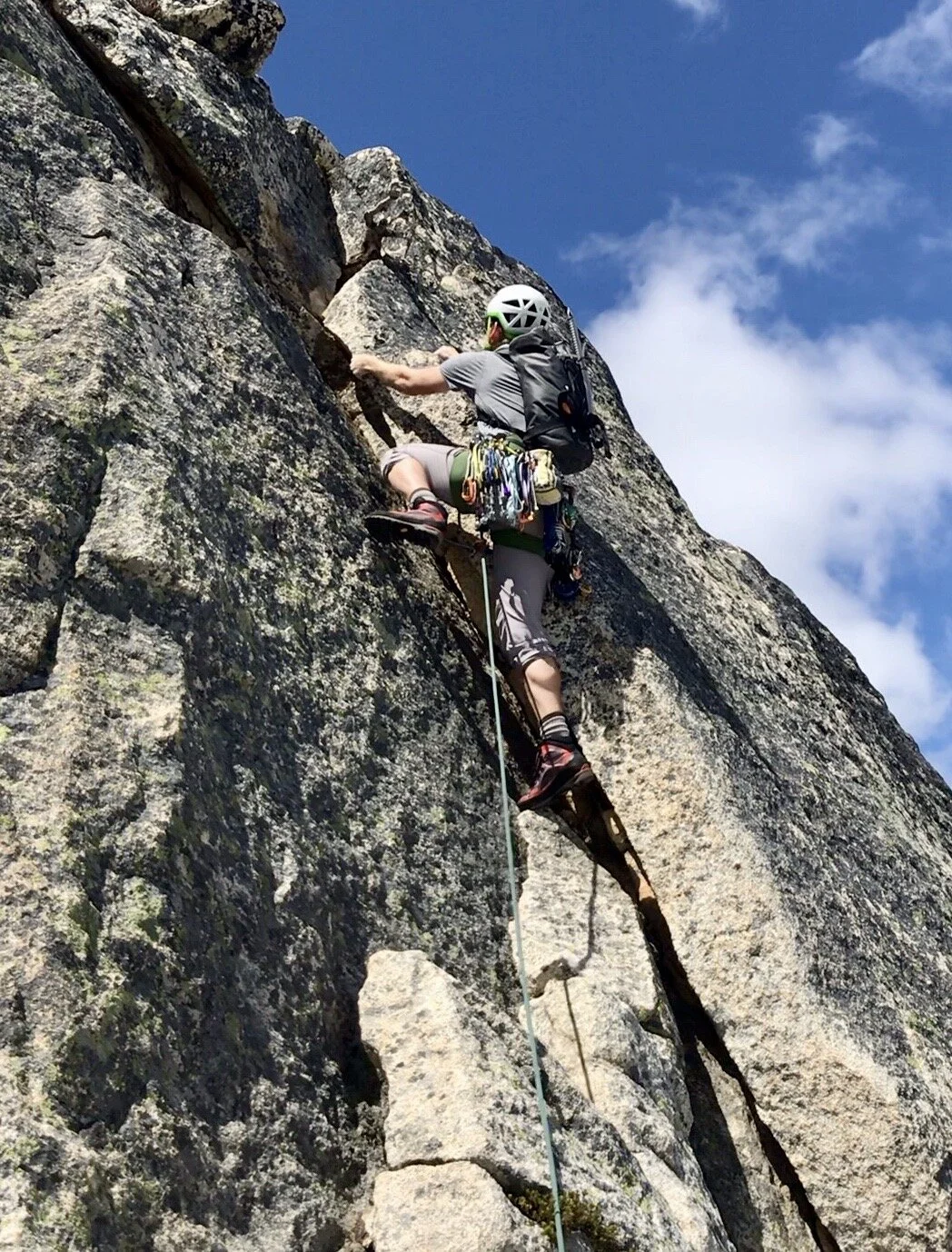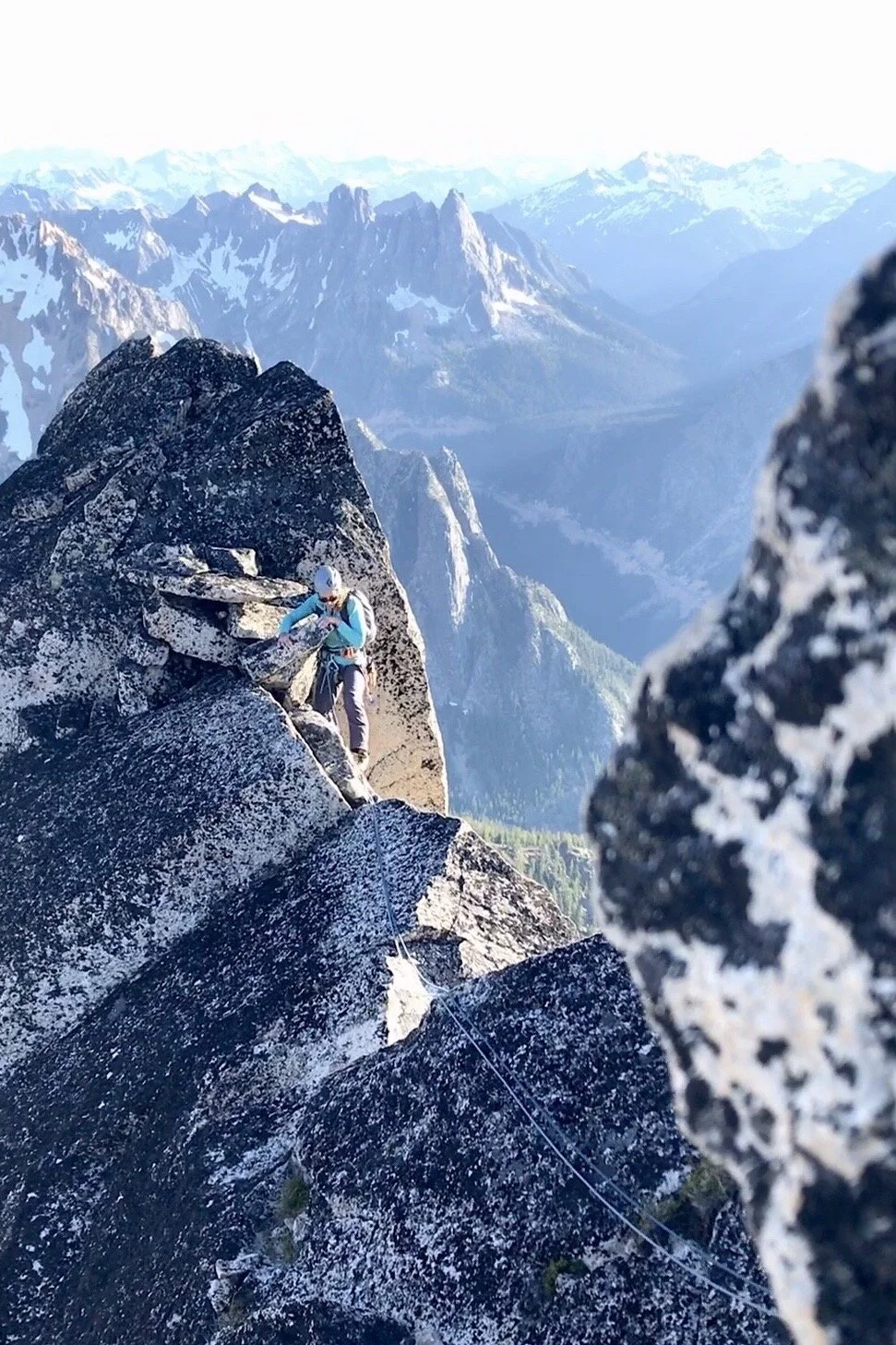Washington Pass: Summer 2020
Words by Dave Shuey. Photos by Dave Shuey, Noémi Shuey, and Patrick Murphy.
Often called the American Alps, in tribute to the rocky spires of prominence and resemblance to their European cousins, the North Cascades offers the rock climber and mountaineer an abundance of worthy objectives. With its access along highway 20, Washington Pass epitomizes North American alpine rock climbing, with often quality granite and moderate approaches.
During the Summer 2020 season, Noémi and I were fortunate enough to live just thirty minutes away in the quaint foothills town of Mazama. In addition to climbing a number of routes on the Goat Wall, building strength while cragging on local stone, and getting into the meat of the range with routes such as the Torment-Forbidden Traverse, we spent seven days exploring nine different rock formations on Washington Pass.
Although a relatively productive season, my time climbing near the pass has only whetted my appetite for alpine rock, and I will undoubtedly return in 2021 to continue where we left off. Below is a short collection of photos and words for remembrance sake of our 2020 season.
Liberty Bell via Beckey Route (SW Face) & Concord Tower via North Face Direct
June 22 — II 5.7 & II 5.8+ — 800’ technical, 2800’ total, 7 pitches
To kick off the season, Noémi and I headed up the mostly snow covered approach to the chilly and windy saddle separating Liberty Bell and Concord Tower. To have the famous Beckey Route (SW Face) of Liberty Bell all to ourselves seemed a rare opportunity. The climbing was pleasant, rock quality superb, and the summit remarkable. The North Face Direct on Concord Tower offered a worthy link-up and helped ensure the hearty approach up to the col worth the effort. A solid first day in the hills!
Poster Peak via Blue’s Buttress
June 29 — III 5.7, moderate snow — 850’ technical, 2400’ total, 11 pitches
One of the goals I had for the season on the pass was to climb routes with a true “alpine rock” nature. Level of difficulty was less important than practicing and employing techniques for efficient movement and transitions through varying alpine terrain. Blue’s Buttress on Poster Peak led itself perfectly to this objective. Although pure rock moves are to be lacking, the collection of utilized skills from approach to transitions between 4th class and mid-5th to a firm snow descent provided a well-rounded adventure and the ideal place to practice guiding in such terrain. It also just so happened to be a great half-day of constant movement.
Cutthroat Peak via South Buttress
July 10 — III 5.8 — 1000’ technical, 3000’ total, 12 pitches
As viewed from the highway, with its pair of rock-spired humps, Cutthroat Peak is an aesthetic mountain, with its South Buttress an obvious objective. Freshly melted snow had both grasses and wildflowers rich in color for the approach. Navigating large moats on the approach gully proved a bit challenging but led us un-roped to the ridge proper. More than a difficulty in climbing movement, route finding provided the crux to our navigation along the ridge. Once through the “humps”, a few delightful sections of climbing brought us to the summit and 360 degree views of the North Cascades. The down climbing descent following the West Ridge offered excellent knife-edge exposure as an extra treat to finish off the climb.
Paisano Pinnacle via West Ridge to Burgundy Spire via North Face
July 15 — IV 5.9 — 1200’ technical, 4500’ total, 13 pitches
With all the deserved attention the Liberty Bell Group receives, Vasiliki Ridge and the Wine Spires are an equally impressive formation just down valley. Like granite bottles aligned across the ridge top, the Wine Spires offer tremendous opportunities for big days in the mountains. The popular and very worthy link-up of Paisano Pinnacle and Burgundy Spire could not be missed.
The fairly steep and continuously switch-backed trail leading from the highway to Bench Camp, will take over where the morning’s coffee left off and ensure your awake and breathing. After a mostly straightforward approach to the base of Paisano Pinnacle, Noémi and I started up it’s West Ridge. A varied route, ascending the arête via cracks and blocks proved good fun, especially as the exposure grew. From the summit of Paisano, the North Face of Burgundy Spire looms before you. Steep and marginally kitty-littered lay backing on the first couple pitches makes way for cleaner rock with added height. A spectacular top out of the spire provides outstanding views of Liberty Group and Vasiliki Ridge. Now just to get back to the highway…
South Early Winter Spire via East Buttress
July 22 — IV 5.11a A0 (one point of aid) — 1100’ technical, 2600’ total, 10 pitches
High on the season’s to-do list, was the classic Beckey route ascending the East Buttress of South Early Winter Spire. It’s line is clear from below and a route immersed with both history and quality steep crack and face climbing. The crack climbing crux in the lower third, follows a steep corner system of varying width before pulling around to the left of an exposed roof. The true technical difficulty arises from the two bolt-protected pitches. The first ascends and traverses impeccable golden granite on thin edges as the line brings you around the corner of the ridge and into the shady NE face. The second climbs straight up a face with shallow pockets before two cool well-protected mantel-shelf moves. Reaching the summit rushed a feeling of contentment and confidence with having completed a route that was on my mind for several years. The always fun down climb and rappel of the South Arête route placed us back on solid ground with a casual hike back to the trailhead.
Juno Tower via Clean Break
August 16 — IV 5.10c — 1500’ technical, 4450’ total, 15 pitches
Teamed up with great pal and roommate Patrick, we began our approach hike up the Silver Star drainage with eyes set on Juno Tower. After navigating and bushwhacking all the Slide Alders one could possibly ask for, we found ourselves donning harnesses below the impressive Clean Break giving the route its apt name. A tricky sequence of movements, with the crux crack too narrow for my hand yet too wide for my fingers, saw me pop off near mid-height. Now carrying with me a forearm pump that would linger for several pitches, Patrick and I swung leads up the tower. Pitch after pitch of quality climbing, led us up 1000 feet before we simul-climbed the remainder to the summit. With a descent off the opposite side towards Bench Camp and the highway, our long day of adventure was topped off with grabbing stashed bicycles and coasting down valley back to the truck.
Le Petit Cheval via Spontaneity Arête
August 19 — III 5.7 — 900’ technical, 2650’ total, 8 pitches
Coincidentally, my final route on the pass for the season would be the one I expected to tackle first. Although not the same caliber as the Liberty Group or Wine Spires, Le Petit Cheval is a large formation of granite with its Spontaneity Arête rising dramatically from its base. Although a fairly casual outing, each pitch of this route offered fun movement while swimming up hand and finger cracks. A worthwhile objective with extraordinary views from a narrow perch upon its top made for a fun outing, and pleasant way to close out our season on the pass.



























